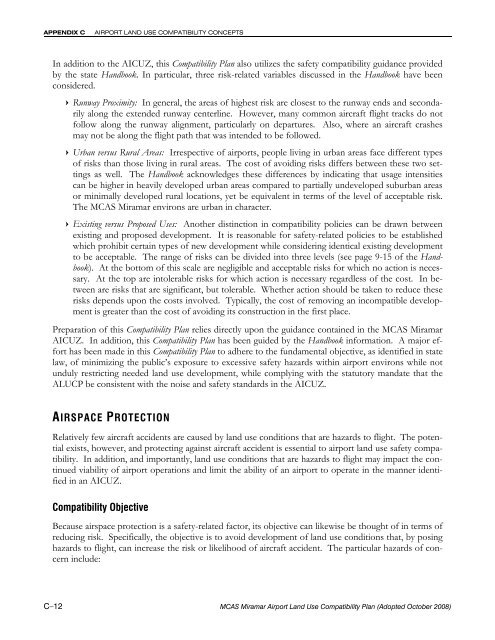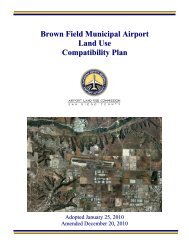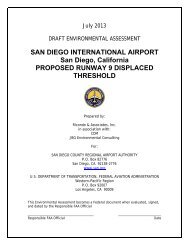MCAS Miramar Airport Land Use Compatibility Plan - San Diego ...
MCAS Miramar Airport Land Use Compatibility Plan - San Diego ...
MCAS Miramar Airport Land Use Compatibility Plan - San Diego ...
Create successful ePaper yourself
Turn your PDF publications into a flip-book with our unique Google optimized e-Paper software.
APPENDIX CAIRPORT LAND USE COMPATIBILITY CONCEPTSIn addition to the AICUZ, this <strong>Compatibility</strong> <strong>Plan</strong> also utilizes the safety compatibility guidance providedby the state Handbook. In particular, three risk-related variables discussed in the Handbook have beenconsidered. Runway Proximity: In general, the areas of highest risk are closest to the runway ends and secondarilyalong the extended runway centerline. However, many common aircraft flight tracks do notfollow along the runway alignment, particularly on departures. Also, where an aircraft crashesmay not be along the flight path that was intended to be followed. Urban versus Rural Areas: Irrespective of airports, people living in urban areas face different typesof risks than those living in rural areas. The cost of avoiding risks differs between these two settingsas well. The Handbook acknowledges these differences by indicating that usage intensitiescan be higher in heavily developed urban areas compared to partially undeveloped suburban areasor minimally developed rural locations, yet be equivalent in terms of the level of acceptable risk.The <strong>MCAS</strong> <strong>Miramar</strong> environs are urban in character. Existing versus Proposed <strong>Use</strong>s: Another distinction in compatibility policies can be drawn betweenexisting and proposed development. It is reasonable for safety-related policies to be establishedwhich prohibit certain types of new development while considering identical existing developmentto be acceptable. The range of risks can be divided into three levels (see page 9-15 of the Handbook).At the bottom of this scale are negligible and acceptable risks for which no action is necessary.At the top are intolerable risks for which action is necessary regardless of the cost. In betweenare risks that are significant, but tolerable. Whether action should be taken to reduce theserisks depends upon the costs involved. Typically, the cost of removing an incompatible developmentis greater than the cost of avoiding its construction in the first place.Preparation of this <strong>Compatibility</strong> <strong>Plan</strong> relies directly upon the guidance contained in the <strong>MCAS</strong> <strong>Miramar</strong>AICUZ. In addition, this <strong>Compatibility</strong> <strong>Plan</strong> has been guided by the Handbook information. A major efforthas been made in this <strong>Compatibility</strong> <strong>Plan</strong> to adhere to the fundamental objective, as identified in statelaw, of minimizing the public’s exposure to excessive safety hazards within airport environs while notunduly restricting needed land use development, while complying with the statutory mandate that theALUCP be consistent with the noise and safety standards in the AICUZ.AIRSPACE PROTECTIONRelatively few aircraft accidents are caused by land use conditions that are hazards to flight. The potentialexists, however, and protecting against aircraft accident is essential to airport land use safety compatibility.In addition, and importantly, land use conditions that are hazards to flight may impact the continuedviability of airport operations and limit the ability of an airport to operate in the manner identifiedin an AICUZ.<strong>Compatibility</strong> ObjectiveBecause airspace protection is a safety-related factor, its objective can likewise be thought of in terms ofreducing risk. Specifically, the objective is to avoid development of land use conditions that, by posinghazards to flight, can increase the risk or likelihood of aircraft accident. The particular hazards of concerninclude:C–12 <strong>MCAS</strong> <strong>Miramar</strong> <strong>Airport</strong> <strong>Land</strong> <strong>Use</strong> <strong>Compatibility</strong> <strong>Plan</strong> (Adopted October 2008)
















